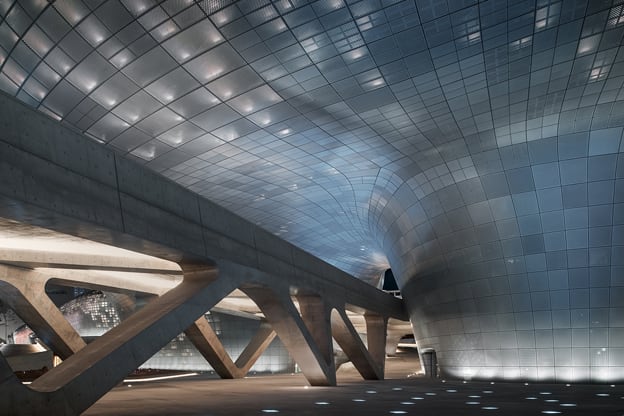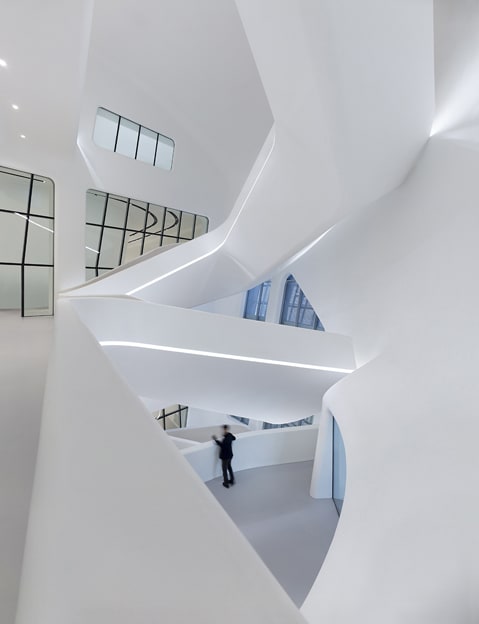- Client: Seoul Metropolitan Government
- Lead Contractor: Samsung Construction and Engineering
- BIM Tools: Digital Project
Dongdaemun Design Plaza in Seoul is one of the South Korean government’s BIM demonstrator projects designed to show how 4D can super-charge the construction process.
The 86,000 sq m cultural hub, designed by Zaha Hadid Architects in collaboration with local studio Samoo, incorporates numerous public spaces, including art and exhibition halls, a design museum, design labs and a design market, a media centre and seminar rooms.
It is a showcase for the late Zaha Hadid’s characteristic fluid geometries, built in a mix of concrete, aluminium, steel or stone, with the cladding alone comprising 30,000 m sq of flat, single-curved and double-curved panels.
Subsequent to winning the international design competition, in 2007, ZHA requested the use of BIM to help meet the tight construction schedule and better control the design. However, cost constraints related to the fact it was a publicly funded project and many South Koreans consider BIM an additional cost to design and construction, meant its use was restricted to the detailed design and construction stages.
The team worked in Digital Project (DP) software to accurately model the complex double-curved geometry. Gehry Technologies was appointed as BIM consultant, by main contractor Samsung Construction and Engineering, due to its strong experience modelling 3D MEP systems on similar complex projects.

Digital Project software proved crucial for the design and manufacture of the facade system
Gehry Technologies trained 10 Samsung staff from scratch to model the entire project in DP, based on a basic 3D model created by ZHA, including the concrete structure, civil works, the facade and MEP systems. Support was provided via bi-weekly BIM meetings with each discipline to improve design coordination and help Samsung get to grips with the unfamiliar processes.
Eddie Can, project architect at ZHA, told BIM+: “Samsung’s team started out working in 3D, but wanted to stick with traditional processes for everything else, which was quite a challenge. However, after a while they realised BIM was helping them and started drawing and cutting sections in the software, particularly for the geometrically complex concrete formwork, and using it to set out on site.”
BIM is oft vaunted as a collaboration tool, but in Seoul Samsung chose to input data into a single 4D model, shared only during meetings for coordination and review purposes.
“We wanted to implement a common data environment for sharing information, but privacy issues made this impossible – Samsung has its own proprietary system and didn’t want to make its cloud system public due to security issues,” says Can.
Prior to start of civil works, 4D simulations were run in DP to demonstrate the construction sequence for temporary works around site, and simulate construction of a mega truss structure for the roof, planning where trucks and other plant would have to manoeuvre to erect the steels.

The software proved crucial for the design and manufacture of the facade system. It was used to generate the secondary space frame structure for the cladding, which was sent to the structural engineer to run final analysis, before being sent to the manufacturer and used to fabricate every node and bar directly.
In addition, the software was used to optimise the design in response to changing client requirements, altering the geometry, cost and constructability to match the capability of the local facade contractor.
ZHA uses Rhino parametric modelling software for most of its design work, but working with DP on Dongdaemun Design Plaza was a lesson in accuracy and tolerance, says Can: “We learnt that we need to reframe our strategy in terms of how we construct and rationalise geometry before we transfer a Rhino design into DP.
“Adding in limiting parameters is more accurate to tolerances, helps control detailing, and is therefore more beneficial for construction. As a result, the final design is still Zaha Hadid but more buildable, with better quality and lower costs.”
All images by Virgile Simon Bertrand
Samsung’s team started out working in 3D, but wanted to stick with traditional processes for everything else, which was quite a challenge. However, after a while they realised BIM was helping them and started drawing and cutting sections in the software.– Eddie Can, project architect, ZHA













